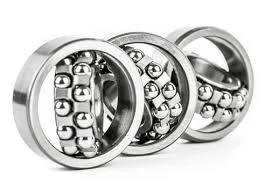
9 月 . 29, 2024 01:35 Back to list
Understanding Angular Contact Ball Bearings for Enhanced Performance and Reliability
Angular Contact Ball Bearings An In-Depth Overview
Angular contact ball bearings play a crucial role in the field of mechanical engineering and industrial applications. Known for their ability to withstand both radial and axial loads, these bearings are essential components in a wide range of machinery and equipment.
Structure and Design
Angular contact ball bearings have a unique design characterized by their bearing rings and balls. The inner and outer rings are designed with a specific angle, allowing the bearings to accommodate axial loads in one direction. This angle is typically in the range of 15 to 40 degrees, depending on the specifications required for the application. The balls themselves are housed in a way that enables them to come into contact with the races at a specific angle, providing enhanced load-carrying capacity.
One of the primary advantages of angular contact ball bearings is their ability to support higher speeds and heavier loads compared to standard ball bearings. Their design allows for a tighter fit and less friction, making them suitable for high-speed applications.
Load Handling Capabilities
Angular contact ball bearings can handle a combination of radial and axial loads, which sets them apart from other bearing types. The axial load capacity increases with the angle of contact; therefore, bearings designed with a larger angle can support higher axial loads. This feature is especially important in applications such as machine tool spindles, automotive gearbox systems, and other machinery where multidirectional loads are present.
Applications
These bearings are widely used in several industries due to their versatility and reliability. Common applications include
1. Aerospace Angular contact ball bearings are vital in engines and landing gear systems. 2. Automotive They are frequently found in drivetrain components and gearboxes where precision and load capacity are paramount.
angular contact ball bearing

3. Industrial Machinery In machine tools that require high-speed motion and movement, these bearings provide the necessary support and durability.
5. Medical Devices In devices like MRI machines and surgical tools, they ensure consistent performance under variable loads.
Advantages and Disadvantages
The primary advantages of angular contact ball bearings include their ability to handle both radial and axial loads, high-speed capabilities, and enhanced rigidity. Moreover, they are available in various configurations, including single-row, double-row, and four-point contact designs, to cater to different application needs.
However, there are some drawbacks to consider. Angular contact ball bearings are generally more complex to assemble compared to other bearing types and may require precise mounting to achieve optimal performance. Additionally, when subjected to misalignment or improper lubrication, their lifespan can be significantly reduced.
Maintenance and Care
To ensure the longevity and functionality of angular contact ball bearings, regular maintenance is essential. This includes proper lubrication, inspection for wear and damage, and alignment checks. Depending on the application, the type of lubricant used can vary, with options ranging from grease to oil, depending on operational conditions like speed and temperature.
Conclusion
In summary, angular contact ball bearings are a vital component in modern engineering applications. Their unique design allows them to handle complex loading conditions, making them suitable for various industries, including automotive, aerospace, and industrial machinery. Understanding their structure, capabilities, and maintenance needs is crucial for maximizing their performance and lifespan, making them indispensable in the mechanical world. As technology advances, the demand for these high-performance bearings is only expected to grow, solidifying their place in the future of engineering.
Latest news
-
Unlocking Efficiency with Spherical Roller Bearings
NewsOct.29,2024
-
The Ultimate Guide to Thrust Ball Bearings
NewsOct.29,2024
-
The Power of Thrust Roller Bearings: Engineered for Excellence
NewsOct.29,2024
-
The Power of Deep Groove Ball Bearings for Your Application Needs!
NewsOct.29,2024
-
The Power and Performance of Cylindrical Roller Bearings
NewsOct.29,2024
-
High-Quality Ball Bearing Manufacturing Machines
NewsOct.29,2024
